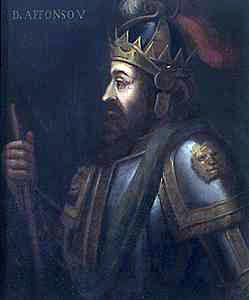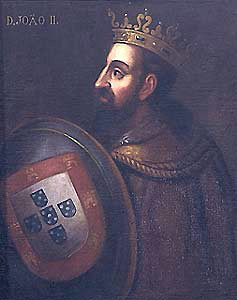Battle of Toro facts for kids
Quick facts for kids Battle of Toro |
|||||||
|---|---|---|---|---|---|---|---|
| Part of the War of the Castilian Succession | |||||||
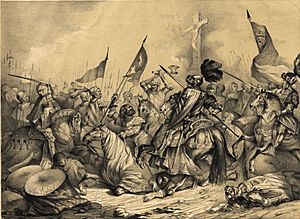 |
|||||||
|
|||||||
| Belligerents | |||||||
|
|
|
||||||
| Commanders and leaders | |||||||
| Afonso V of Portugal Prince John of Portugal Bishop of Évora Archbishop of Toledo |
Ferdinand II of Aragon Cardinal Mendoza Duke of Alba Álvaro de Mendoza Count of Alba de Aliste (POW) |
||||||
| Strength | |||||||
|
About 8,500 men:
|
About 8,000 men:
|
||||||
| Casualties and losses | |||||||
| Near 1,000 | Many hundreds (dead and prisoners) | ||||||
The Battle of Toro was a major fight during the War of the Castilian Succession. It happened on March 1, 1476, near the city of Toro. The battle was between the armies of Afonso V of Portugal and Prince John of Portugal, and the forces of the Catholic Monarchs, Ferdinand and Isabella.
Even though both sides claimed victory, the battle was not a clear win for either army. However, it was a huge political success for Isabella. It helped her secure her place as the Queen of Castile. This battle was a turning point in the war. It helped lead to the union of Castile and Aragon, which later formed modern Spain.
Contents
Why the Battle Happened
The Battle of Toro was part of a bigger conflict called the War of the Castilian Succession. This war started after King Henry IV of Castile died in 1474.
Who Wanted the Throne?
Two main people wanted to be the next ruler of Castile:
- Isabella: She was King Henry's half-sister. Most nobles, church leaders, and common people supported her.
- Juana: She was King Henry's daughter. Some powerful nobles supported her. She was also known as Juana la Beltraneja.
This disagreement quickly turned into a civil war. King Afonso V of Portugal got involved to support his niece, Juana. He even married her. His goal was to unite the crowns of Portugal and Castile. This was an alternative to the union of Castile with Aragon, which was happening through Isabella's marriage to Ferdinand.
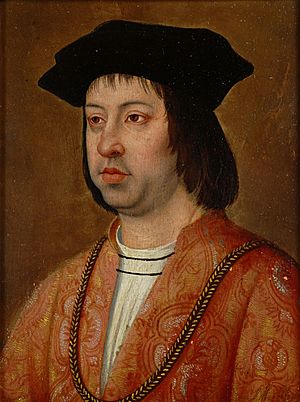
Before the Battle: Zamora Siege
King Afonso V wanted to protect his cities along the Duero River. But on December 4, 1475, part of the garrison in Zamora rebelled. Zamora was an important city for Juana's supporters. Ferdinand entered the city the next day.
In February 1476, Afonso V received more troops led by his son, Prince John. Their combined forces then surrounded Ferdinand's army inside Zamora. After two cold and rainy weeks, the Portuguese decided to leave. They went to rest in the city of Toro. Ferdinand followed them. Both armies decided to fight near Toro.
The Armies and Their Leaders
Both armies had about 8,000 to 8,500 soldiers. They were made up of foot soldiers and horsemen.
Isabella's Army (Castilian-Aragonese)
- Center: Led by Ferdinand himself. It included the royal guard and soldiers from cities like Zamora and Valladolid.
- Right Wing: Made of light cavalry. It was led by captains like Álvaro de Mendoza.
- Left Wing: This was the strongest part. It had heavily armored knights. Key leaders here were Cardinal Mendoza and the Duke of Alba.
Afonso V's Army (Portuguese-Castilian)
- Center: Led by Afonso V. It included Portuguese nobles and Castilian knights loyal to Juana.
- Right Wing: Troops from some Portuguese nobles and the Castilian Archbishop of Toledo, Alfonso Carrillo.
- Left Wing: This was the elite part of the army. It included skilled knights, arquebusiers (soldiers with early firearms), and javelin throwers. It was commanded by Prince John.
The Battle Unfolds
Prince John's Victory on One Side
Prince John's forces attacked the right side of Ferdinand's army. They used arquebusiers and javelin throwers. The Castilian forces were quickly defeated and ran away.
- A Castilian writer, Hernando del Pulgar, said: "those 6 Castilian captains... were invested by the prince of Portugal... turned their backs and put themselves on the run."
- A Portuguese writer, Garcia de Resende, noted: "they could not stand the hard fight and were rapidly beaten and put on the run with great losses."
The Prince's men chased the fleeing Castilians. Prince John, being a smart leader, stopped his main troops to keep them together. Some of his men chased too far and were captured or killed.
Some Castilian writers said that Ferdinand left the battlefield early. They said he went back to Zamora because he heard that Portuguese troops in Toro might attack his camp. However, Portuguese writers said Ferdinand left because his right wing was defeated.
Ferdinand's Army Wins on the Other Side
Meanwhile, other parts of the Castilian army fought fiercely. Ferdinand's center attacked the Portuguese center. The Castilian left wing, led by Cardinal Mendoza and the Duke of Alba, attacked the Portuguese right wing.
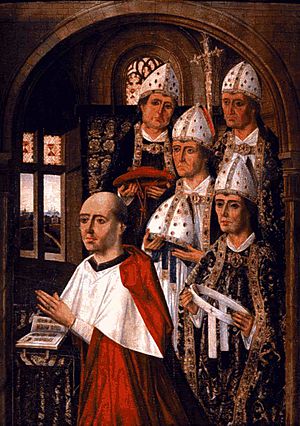
The Portuguese began to break apart. The fight around the Portuguese royal flag was intense. The flag carrier, Duarte de Almeida, lost both hands but held the flag with his teeth until he fainted.
Afonso V saw his flag lost. He thought his son's forces had also been defeated. He wanted to die fighting, but his men took him away to safety.
Many Portuguese soldiers scattered. Some drowned in the Duero River in the dark and confusion. The Castilians captured 8 flags and looted the Portuguese camp. However, the loot was not much because it was a very dark night.
Pulgar wrote that many died on both sides. He said Portuguese soldiers drowned while trying to escape across the river.
The night was dark and rainy, causing much chaos. Soldiers from both sides were mixed up. Some Portuguese even shouted "Ferdinand!" to trick their pursuers.
After the battle, Ferdinand quickly sent letters to cities in Castile. He claimed a great victory. He did not mention that part of his army was defeated or that he had retreated.
Prince John also sent letters to Portugal's main cities, Lisbon and Porto. He ordered celebrations for his triumph at Toro. He did not mention his father's defeat.
Isabella ordered a thanksgiving procession. She also built a beautiful church in Toledo, the Monastery of S. Juan de los Reyes. This was to celebrate her victory and remove any doubts.
Historian Justo Gonzalez said: "Both armies faced each other at the camps of Toro resulting in an undecided battle. But while the Portuguese King reorganized his troops, Ferdinand sent news to all the cities of Castile... about a huge victory... Faced with these news, the party of 'la Beltraneja' [Juana] was dissolved and the Portuguese were forced to return to their kingdom."
Prince John Controls the Battlefield
Prince John returned after chasing the enemy. He defeated some Castilian soldiers who were looting. He then took a defensive position on a hill. He lit large fires and played trumpets. This was to guide his scattered men back and challenge the enemy.
Prince John's men captured some prisoners, including Ferdinand's uncle. They also got back his father's royal flag.
The Castilian leaders, Cardinal Mendoza and the Duke of Alba, tried to gather their men to attack Prince John. But they could not convince their soldiers to move.
Pulgar said the Castilians were tired and it was too dark to see. He said they went back to Zamora. The Portuguese writers said the Castilians left in disorder, like defeated men.
Prince John stayed on the battlefield for most of the night. He saw that the enemy had fled. He then marched triumphantly to Toro with his prisoners. He ordered the city gates opened and restored order. The next day, he found his father, the King. He also sent men to bury the dead and write an official victory report.
Both Castilian and Portuguese records confirm that Prince John remained in control of the battlefield. This means he was the last one standing there.
What Happened After
The Battle of Toro was not a clear military win. But politically, it was a huge victory for Isabella. It helped her become the Queen of Castile.
After the battle, Afonso V went to France to ask for help. He knew Portugal could not win against Castile and Aragon alone. Castile and Aragon had a much larger population and area than Portugal.
Many nobles who supported Juana changed sides in the following months. Most undecided cities and castles also joined Isabella's side. This was a slow but steady process.
Even though the Portuguese army was weaker, they kept fighting in Castile for over three months. They captured and burned castles and villages. They even tried to capture King Ferdinand and Queen Isabella.
Ferdinand's army did not directly attack the Portuguese. Instead, they surrounded strongholds that supported Juana. They also negotiated with rebel nobles.
The Catholic Monarchs' plan worked. They put pressure on Portugal's borders. They also started a naval war to attack Portugal's power at sea and its gold trade. This forced the Portuguese army to return home.
Peace at Alcáçovas
The war continued, especially at sea. But eventually, both sides decided to negotiate. The Treaty of Alcáçovas was signed in 1479.
In this treaty:
- Isabella was recognized as the Queen of Castile. She agreed to give up her claims to the Portuguese crown.
- Portugal gained control of navigation and trade in most of the Atlantic Ocean. The Canary Islands remained with Castile.
- Portugal also gained the right to conquer the Kingdom of Fez (Morocco).
This treaty ended the war. It showed that both sides had won something. Isabella secured her throne, and Portugal gained important trade rights.
Toro and Modern Spain
The Catholic Monarchs were very smart. They turned an unclear battle into a great political victory. This victory helped them secure the crown. It also laid the groundwork for the Spanish nation.
The Monastery of S. Juan de los Reyes was built to celebrate this victory. It marked the start of the union of Castile and Aragon.
Later, Spain conquered Granada and discovered the New World. Spain became very powerful in Europe. This led to the "Siglo de Oro" (Spanish Golden Age). Portugal and its empire even joined Spain for a time, creating a huge empire "where the sun never sets."
Today, Spain and Portugal are good friends. They often call each other "our brothers." Battles like Toro are now just part of a long history.
Images for kids
-
An anachronous map of the Portuguese Empire (1415–1999)
See also
 In Spanish: Batalla de Toro para niños
In Spanish: Batalla de Toro para niños


